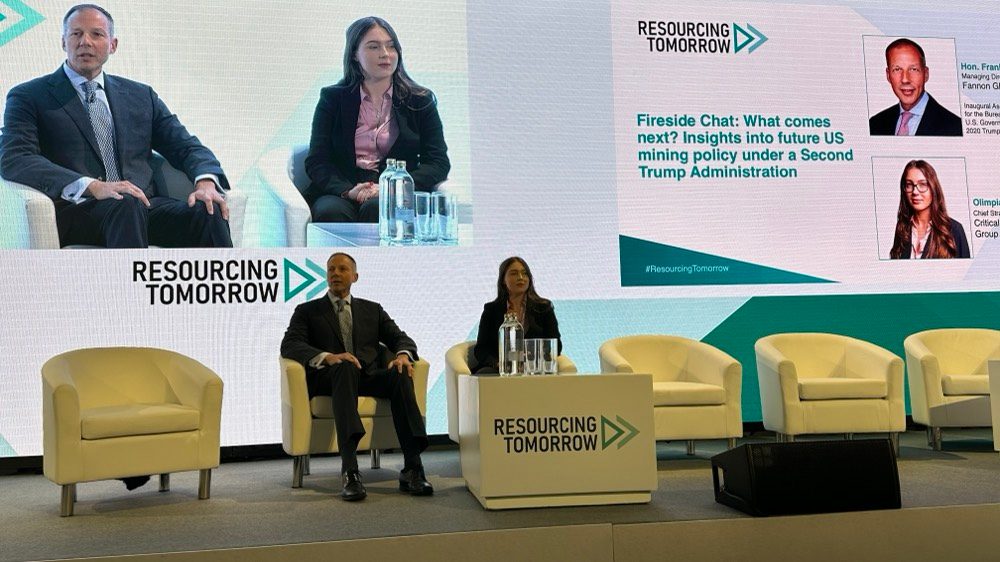The US approach to competing with China on critical minerals is likely to fundamentally shift under a second Trump presidency, combining both tariffs and subsidies rather than relying on subsidies alone, according to Fannon.
“What we haven’t seen is the corresponding tariffs. So we’ve only been developing a race against China’s [subsidies]. And that’s a race that the US as well as any free-market economy is destined to lose,” Fannon told delegates.
He explained the current strategy using President Reagan’s principle: “If you want more of something, subsidize it… if you want less of it, tax it.”


During Trump’s first term, the introduction of a 25% tariff on Chinese gallium imports in 2019 led to initial stockpiling, which ultimately helped buffer later supply shocks when China implemented export controls.
Chinese content rules shake-up
A second Trump administration would likely tighten restrictions on Chinese content in products receiving US government incentives, particularly in the electric vehicle supply chain, Fannon said in the fireside chat titled “What comes next? Insights into future US mining policy under a Second Trump Administration.”
“In the context of electric vehicle credits… if it comes from China, then it should not benefit from US taxpayer subsides,” he said, adding that the Biden administration’s allowance of “up to 25% Chinese content” would likely be scrapped as it “sends a mixed signal to the investment community.”
In September 2024, under President Biden, the US Trade Representative announced its final determination on Section 301 tariffs for Chinese critical minerals imports. The changes include a 25% tariff on indium, tantalum and chromium imports effective September 27, 2024, with additional tariff increases on other materials to be implemented in stages through 2026.
Fastmarkets assessed indium 99.99%, in-whs Rotterdam at $340-380 per kg on Wednesday December 4, unchanged since November 20, following a slight downward trend since October 23 but remaining largely stable.
The potential policy shift comes amid fresh concerns about Chinese control of critical mineral supply chains, highlighted by China’s expanded export controls on gallium and germanium implemented August 1, 2023, followed by restrictions on antimony exports from September 15, 2024, with new measures announced December 3 requiring stricter licensing and end-user reviews for exports to US entities.
Investment climate shift
The emphasis under a second Trump administration would shift from international forums to tangible development outcomes, according to Fannon.
“More convenience and more conferences don’t move tons… there’s going to be a very clear [key performance indicator]… Moving the tons of and the investment is the outcome,” he said.
The private sector’s role would be central to this approach.
“In our system, the government can establish parameters for action, but it doesn’t actually do anything… it’s the private sector that actually is the instrument,” Fannon said.
However, he warned that frequent policy changes between administrations create challenges for investors: “The pendulum swings we’re seeing [are] unhelpful for capital formation and creating a confidence to actually invest in certain jurisdictions, including the United States.”
Permitting reform potential
While permitting reform was initiated during Trump’s first term, the effort was disrupted by Covid-19, Fannon said. He indicated this would be revisited, as “you need to be able to build stuff.”
“How that’s tackled… I think that’s a bipartisan issue… How does one tackle it, how do we address it? What does reform look like, and how it can be for years is a very short point of time to address these long-term challenges,” he said.
Fannon pointed to state-level differences, citing Tesla’s move from California to Texas as an example: “Texas represented a place where you can build things. Capital is welcome.”
He noted that most of America’s “battery belt” is in Republican-led states, despite federal funding being available nationwide.
“Permitting takes 10-15 years to [start up] a mine, with timelines of 20 years. That’s the biggest bottleneck to the business cases,” Rolf Kuby, director general of Euromines, told Fastmarkets in an exclusive interview at Resourcing Tomorrow.
International cooperation restructure
While existing international frameworks like the Minerals Security Partnership may continue, they would likely be restructured to focus more on concrete outcomes under a second Trump presidency, Fannon said.
The Minerals Security Partnership (MSP) is a collaboration of 14 countries and the EU to catalyze public and private investment in responsible critical minerals supply chains. MSP partners include Australia, Canada, Estonia, Finland, France, Germany, India, Italy, Japan, Norway, South Korea, Sweden, the UK the US and the EU.
“It’s very difficult to create multi-national fora and agreements… it is painstaking work and takes far too long,” Fannon said, drawing from his own government experience. While acknowledging these forums create an important foundation, he emphasized that “having the meeting is not the outcome.”
Instead, future cooperation would likely prioritize capital deployment.
“You’re going to see a bit of a different approach… which will have the convenience of government… But there’s going to be a focus on action and deployment of capital,” he said.
The shift back to security as the “north star” of US policy would necessitate continued international investment.
Fannon said: “There’s a clear recognition… that the US – even though we have an amazing minerals endowment – it’s the time horizon that’s necessary to develop them… and that means investment overseas and partnerships overseas.”






